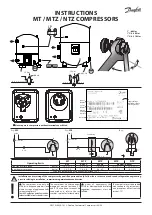
v.220629 | 21
TROUBLESHOOTING
SYMPTOM
CORRECTIVE ACTION
Air leaks at the
check valve or at the
pressure relief valve
A defective check valve results in a constant air leak at the pressure release valve when
there is pressure in the tank and the compressor is shut off. Drain the tank, then remove
and clean or replace the check valve.
Air leaks between
head and cylinder.
Be sure of proper torque on head bolts. If leak remains, contact a service technician.
Air leak from safety
valve.
Operate the safety valve manually by pulling on the ring. If the valve continues to leak
when in the closed position, it should be replaced.
Pressure reading
on the regulated
pressure gauge
drops when an
accessory is used.
If there is an excessive amount of pressure drop when the accessory is used, replace the
regulator.
NOTE: Adjust the regulated pressure under flow conditions (while accessory is being
used). It is normal for the gauge to show minimal pressure loss during initial use of the
tool.
Excessive tank
pressure.
Move the Auto-On/Off lever to the Off position. If the unit doesn’t shut off, unplug it from
the power source and contact a service technician.
Motor will not start.
Make sure power cord is plugged in and the switch is on. Inspect for the proper size fuse
in your circuit box. If the fuse was tripped reset it and restart the unit. If repeated tripping
occurs, replace the check valve or contact your service technician.
Excessive moisture
in the discharge air.
Remove the water in the tank by draining after each use. High humidity environments
will cause excessive condensation. Utilize water filters on your air line.
NOTE: Water condensation is not caused by compressor malfunction. Be sure the
compressor’s air output is greater than your tool’s air consumption rate.
Air leaks from the
tank body or tank
welds.
Never drill into weld or otherwise modify the air tank or it will weaken. The tank
can rupture or explode. Compressor cannot be repaired. Discontinue use of the air
compressor.
ENGLISH
Summary of Contents for AC10G
Page 5: ...SECTION I SAFETY ...
Page 11: ...SECTION II INSTALLATION ...
Page 14: ...SECTION III OPERATION ...
Page 18: ...SECTION IV MAINTENANCE ...
Page 22: ...SECTION V PARTS SCHEMATICS ...
Page 25: ...v 220629 25 SCHEMATICS ENGLISH ...
Page 30: ...SECTION I SÉCURITÉ ...
Page 37: ...SECTION II INSTALLATION ...
Page 40: ...SECTION III FONCTIONNEMENT ...
Page 44: ...SECTION IV ENTRETIEN ...
Page 48: ...SECTION V PIÈCES ET SCHÉMAS ...
Page 51: ...v 220629 51 SCHÉMAS FRANÇAIS ...
Page 52: ......
















































